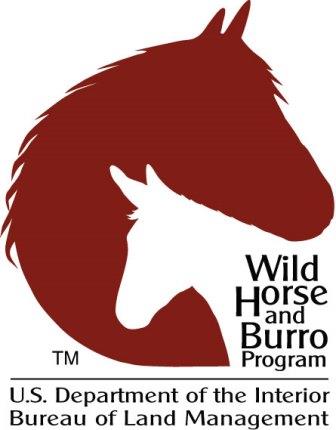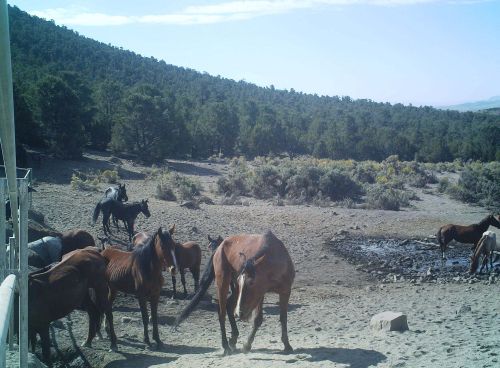2016 Pancake Emergency Wild Horse Gather
Progress as of October 4, 2016
Purpose of Gather:
To remove excess wild horses from the Big Sand Spring Valley portion of the Pancake herd management area (HMA), located about 30 miles west of Ely or 80 miles northeast of Tonopah, due to declining water availability. The BLM monitors water sources districtwide and since late August has been hauling water to Martilletti and Moody Springs which have significantly declined in water production. Despite BLM efforts, water remains limited at the springs and two very small neighboring water sources.
Details of Gather:
The BLM will utilize the services of a Federal gather contractor to conduct a bait/water trap gather. Appropriate Management Level (AML) for the Pancake HMA is 240-493 wild horses. The current population is estimated at 1,800 wild horses based on a March 2016 population inventory.
Public Observation:
Because of the need for wild horses to adjust to the hay and corrals in a quick and safe manner, only essential wild horse personnel will be allowed at the gather sites during initial operations.
Depending on the animals’ adjustment, public viewing through an escorted tour of the temporary holding facility may be arranged at some point during the gather.
Adoption Information:
Wild horses removed from the Pancake HMA will be transported to the Indian Lakes off-range corrals, in Fallon, Nev., to be prepared for the BLM’s adoption program. Animals for which there is no adoption demand will be placed in off-range pastures where they will be humanely cared for and retain their “wild” status and protection under the 1971 Wild Free-Roaming Horses and Burros Act. The BLM does not sell or send any horses to slaughter.
Background:
The approximately 1,259,739-acre Pancake Complex is typical of the Great Basin region, characterized by north-south trending mountain ranges. Significant features are large flat valley bottoms and steep mountains with elevations ranging from about 5,000 feet on the valley floors to 11,000 feet atop the mountain peaks. The area is remote and rugged. Vegetation in the HMA consists primarily of brush, fir and mountain mahogany in the higher elevations, pinion-juniper and sagebrush on the lower mountain slopes and white sage, black sage, saltbush and other “salt desert shrub” type communities on the valley floors.
The area falls within the Great Basin Desert which encompasses much of Nevada and western Utah, portions of southern Oregon and small parts of California and Idaho. The Great Basin is effectively cut off from the westerly flow of Pacific moisture due to crossing air masses created by the Sierra and Cascade mountain ranges that cool and precipitate much of the moisture out. The result is a cold, dry desert. Precipitation in the Pancake Complex ranges from approximately five inches on the valley bottoms to 20 inches on the mountain peaks. Most of this precipitation comes in the form of snow during the winter months. Summers are hot and dry, with high temperatures in the 90s or higher. Winters are cold, with temperatures dropping to as low as 20 degrees below zero.
For more information on the Wild Horse and Burro Program, call 1-866-468-7826 or email [email protected].
Pictures of the conditions at the springs:

- Gather Reports
Tuesday, September 27
Summary: 10 studs, 5 mares, 3 foals have been gathered. Operations will continue at same trap site.
Animals gathered: 18
Animals shipped: 0
Total deaths today: 0
Acute:
Chronic/Pre-existing:Wednesday, September 28
Summary: 12 studs, 16 mares, 10 foals have been gathered. Operations will continue at same trap site.
Animals gathered: 38
Animals shipped: 0
Total deaths today: 1
Acute: 1*
Chronic/Pre-existing:* broken neck.
Thursday, September 29
Summary: 9 studs, 1 mares, 1 foal have been gathered.
Animals gathered: 11
Animals shipped: 0
Total deaths today: 1
Acute: 0
Chronic/Pre-existing: 1** pneumonia with a Henneke body condition score of 2 with a poor or hopeless prognosis for improvement
Friday, September 30
Summary: 5 studs have been gathered.
Animals gathered: 5
Animals shipped: 0
Total deaths today: 0
Acute: 0
Chronic/Pre-existing: 0Saturday, October 1
Summary: 9 studs, 13 mares, 5 foals have been gathered.
Animals gathered: 27
Animals shipped: 0
Total deaths today: 0
Acute: 0
Chronic/Pre-existing: 0Sunday, October 2
Summary: No horses gathered.
Animals gathered: 0
Animals shipped: 0
Total deaths today: 0
Acute: 0
Chronic/Pre-existing: 0Monday, October 3
Summary: 2 studs, 5 mares, 3 foals have been gathered.
Animals gathered: 10
Animals shipped: 0
Total deaths today: 0
Acute: 0
Chronic/Pre-existing: 0Tuesday, October 4
Summary: 11 studs, 15 mares, 4 foals have been gathered.
Animals gathered: 30
Animals shipped: 0
Total deaths today: 0
Acute: 0
Chronic/Pre-existing: 0---
A death labeled as "acute" is when an animal dies or is euthanized due to acute injuries or medical conditions brought about by the gather and removal process including those that occur during capture, sorting and holding at the gather site. This term will include animals that die for known or unknown reasons thought to be related to gather activities.
A death labeled as "chronic/pre-existing" is when an animal dies or is euthanized for reasons related to chronic or pre-existing conditions such as body condition, lameness, serious physical defects, etc. This term will include animals that are euthanized for conditions not brought about by the gather activity.- Veterinary Reports
There are no veterinarian reports to display at this time.
